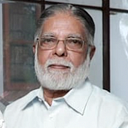Oil Painting with Fingers
Prof. Devendra Lal, a brilliant scientist and my former boss at the Physical Research Laboratory, once told me of paintings he did with bare hands while he was at the Tata Institute for Fundamental Research. He persuaded me to try this technique to appreciate the sensuality and fluidity of the wet paint on canvas. I found this very productive since one could directly communicate to the canvas bypassing the intermediary of the brush. The ‘Old Fort’ shown at the top of this piece was a painting I had made in the early nineties.
I realized at that time that each technique creates its art. For example, the Mexican painter David Alfaro Siqueiros, known for his murals, is considered one of the earliest painters to abolish the paintbrush. He set up a workshop in New York city in 1936 to experiment with varieties of painting techniques where radical painters converged to experiment with techniques and materials.
One of the celebrated painters who sought liberation from the tyranny of the brush was Jackson Pollock. He used a drip technique to create abstract expressionist paintings. He did this by poking a hole in a tin of paint and dripping paint on the canvas and earning the name ‘Jack the dripper’ in art circles. The randomness of this process and the non-reproducibility renders a freshness to his painting. He was inspired by ‘Existentialist’ thinking. Ukranian born Janet Sobel whose 1945 drip canvas Milky Way is an Abstract Expressionist. Sobel’s work has been exhibited as “Women in Abstraction” at the Centre Georges Pompidou in Paris last year.
As early as the 15th-century, Japanese painters who belonged to Zen Buddhist school investigated splashing ink. Members Dada and Surrealist movements also used this process with a high element of randomness. Splattering and dripping draws attention to how the painter and the body are connected (1).
Another painting technique termed pouring involves pouring paints of different colours directly onto a canvas to produce random patterns. This method is said to have originated with David Alfaro and became popular during Abstract Expressionism. This gave rise to compositions which celebrated pure colour as in the Post-Painterly Abstraction movement.
Pulling and scrapping techniques imply the dragging of the paint across the surface or the scrapping it with a palette knife. This method is attributed to the Dutch painter Willem de Kooning and the German painter Gerhard Richter. They created abstract expressionist portraits by depositing a thick layer of paint and spreading it using the pulling and scrapping method.
In the ancient process of using body casting, the human body became the replacement for the brush (2). Its entry into visual arts goes back to the 1960s. The French painter Yves Klein exploited the body as a painting tool in the process of artistic creation. During the 60s, Klein created the anthropometry paintings associated with him in a live programme with audience participation. He would roll his models in his celebrated blue art pigment; the models transferred their body imprints to large sheets of paper.
Brooklyn-based painter Iris Scott gave up brushes and palette knives in favour of using her fingers. Scott picked up her technique during a year spent travelling in Southern Taiwan. Her canvases of thick oil paint in saturated colours capture dreamy urban cityscapes. “There’s nothing between me and the paint, I feel all the tiny nuances,” claims Scott. “I can manipulate thick paint with my fingers in ways brushes never could” (3). The physicality of using her fingers brings a sense of flow to her painting. Each canvas becomes fascinating with more than 100 colours for a single composition. Her Facebook following is close to 350,000. Her “Finger Painting Weekend Workshop”, has resulted in an Amazon publication, A Beginner’s Guide to Creating Brush-Free Works of Art, in January 2016.
From digit to digital painting was an expected transition for Jorge Colombo. In his experiment, he threw out paints and canvas and replaced them with his iPhone and iPad to illustrate magazine covers and create incredible artwork (4). His work has appeared as cover picture for The New Yorker magazine in 2009. He is obsessed with New York City, but his repertoire extends to landscapes and portraits. His technique illustrates the enhancement of human creative potential by technology. His work is in worldwide galleries. Colombo’s publications include Fullerton, Of Big and Small Love, and Lisboa Revisited.
More than any other means of expression, painting has an emergent element. We do not always know where the picture is going. Conclusion: there is complex feedback from the image and our state of mind, which changes the outcome. The painter is subconsciously led a certain way determined by the painting. Finger painting firmly establishes this feedback-enhanced direct communication between the mind and the canvas. The satisfaction a picture gives a painter is in discovering its final form, which eludes him until the last dash makes a mark on the canvas.
References
1. https://www.widewalls.ch/magazine/splattering-dripping
2. https://www.thisiscolossal.com/2016/03/vibrant-oil-finger-paintings-by-iris-scott/
3. https://www.widewalls.ch/magazine/body-printing
3. https://www.bravethewoods.com/blog/jorge-colombo-finger-paintings
